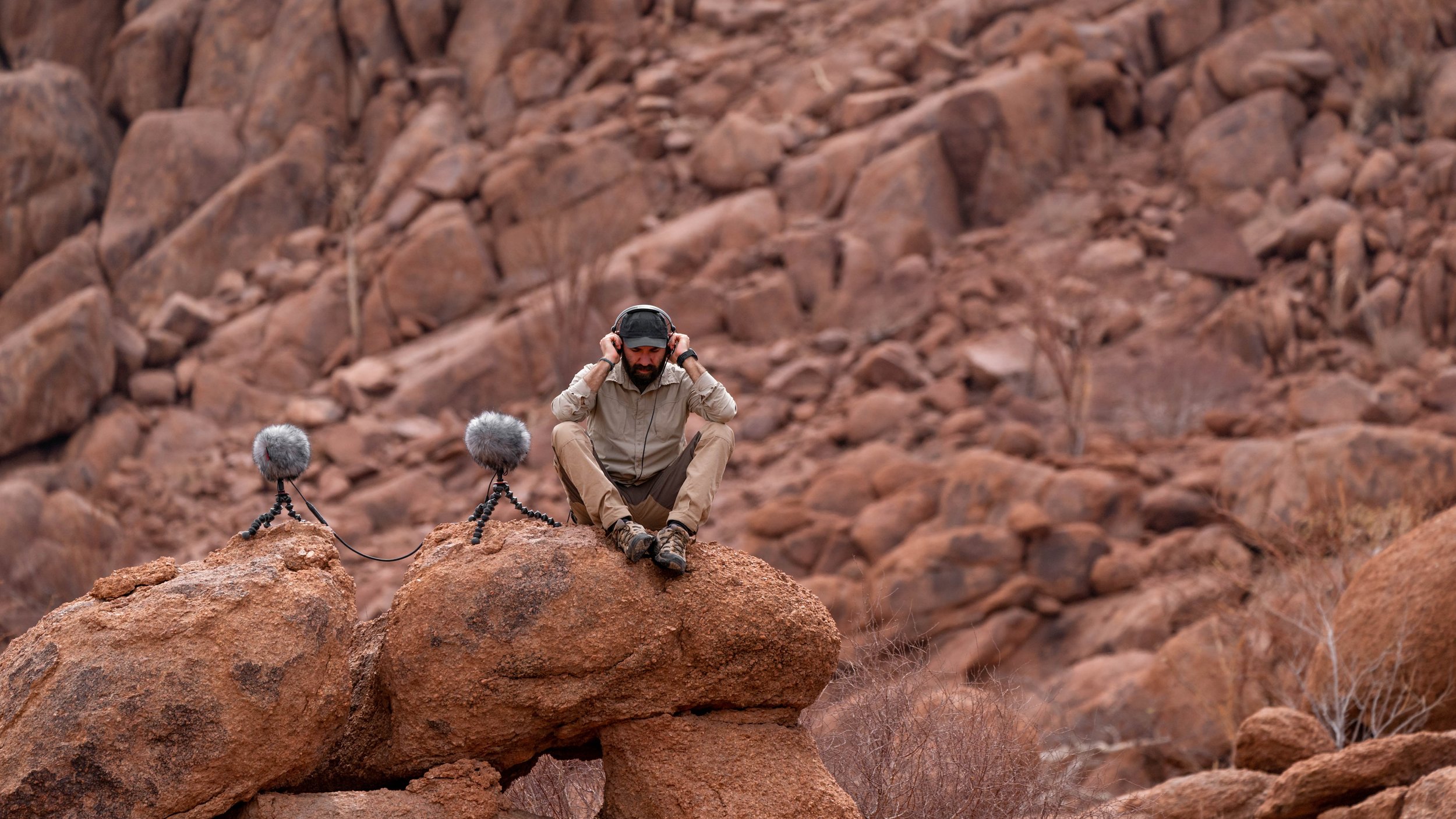I just got back from a jungle sound recording expedition to Sumatra where I had ample opportunity to test my kit in extreme conditions. My microphones and recorders were exposed to long days in very hot temperatures and crazy humidity, and to a few attacks from several ant species. What was affected and which gear survived? Read on to find out.
I started to take field recording seriously some 13 years ago, and I’ve never pampered my equipment. I’ve had recorders freeze, I dropped microphones in water, I drowned dozens of lavs, I smoked mics and blimps over an active volcano - just to name a few of the crazy adventures my kit has been through. If I worked in a studio, I could afford to be overprotective of my equipment, but the kind of work I do simply doesn’t allow for it.
I have to mention I’m in the fortunate position where I can afford to lose equipment. I have a generous kit budget and I also get free stuff from manufacturers, so I may be biased towards putting my kit through more risk than your average sound recordist. Please don’t try to replicate these situations unless you’re prepared to lose your equipment.
Disclaimer #2: I’ve been sponsored and supported by brands (Sennheiser, Rycote, Bubblebee, Telinga, Schoeps, Lom) in the past but I’m not paid to write this. The sponsorships I received were not in exchange for positive endorsements.
Recorders
Sound Devices Mixpre 3 ii vs fire ants
When the first Sound Devices Mixpre series came out, I bought one right away and felt let down by their promises and my previous experiences with the brand. The second series fixed some of those issues but still felt a bit limited, which was reflected in my new review. After a few years I can say I’m using 2nd gen Mixpres on all of my expeditions unless the shoot is something critical. In Costa Rica I had a rig destroyed by fire ants after leaving it in the jungle for about 30 hours, but to my surprise the Mixpre 3 ii survived! It was crawling with ants when I collected it and it had been exposed to mud and humidity for many hours. I was very impressed with the Mixpre gen ii series for surviving such a vicious attack.
The Zoom F6 has seen some action too - bitten by a curious baboon while recording in the Masai Mara. I also dropped it a few times and bumped it around in a poorly packed bag on another expedition. When I finally noticed it, the play button was totally pushed in and moved slightly to the side. A little careful surgery with my Leatherman and the F6 is working again with no issue.
The Zoom F3 has been very useful on expedition as well, especially given its diminutive size. I’ve had some issues with microSD cards getting stuck in, and some power failures in below freezing temperatures so it’s worth bringing several of these on a trip in case one of them decides to cause problems. Having said that, the F3 is still my go-to device when size and power efficiency are very important.
Of course no device is perfect. I would choose my 633 or a Sound Devices 8-series if I was traveling to seriously tough locations like Papua New Guinea or Antarctica, for example. In extreme situations I wouldn’t rely on a single-SD card device, and the 633 has dealt with everything I could throw at it. I recorded with it in 50C/122F temperatures, on the edge of an active volcano, I left it out in temperatures way below freezing for more than 12 hours at a time and the list can go on. The only reason I’m not taking it with me as much anymore is its size and weight.
The Sony D100 is still my favourite handheld recorder. I have two of them now and I use them both with the built-in mics and with external PIP lavs. In Costa Rica, one of the D100s was recording in over 80% humidity for several days and had no issue at all. The Sony PCM A10 on the other hand is the perfect drop rig recorder. I have 4 of them and they’re out in dry bags for most of the time I’m on expeditions. They’re small, power-efficient and they make solid, relatively clean recordings when paired with Clippy or Lom lavs.
Microphones
Sennheiser MKH8020 with Rycote Nanoshield
What are the best suited microphones for high humidity? Two brands come to mind. Sennheiser MKH series with their RF technology and DPA lavs like the 6060. I use both and I can assure you that it’s not just empty hype. I once dropped the MKH8060 in a lake, picked it up and kept recording with no problem whatsoever. I’ve left my DMS rig (MKH30 and two MKH8040s in a Cinela Pianissimo waterproofed blimp) in rainforests across Africa, the Americas and Asia for days at a time and they never caused me any problems. I only got the DPA 6060s recently but I left them out in pouring rain with only Bubblebee Windbubbles on for a few days in Costa Rica. They sounded muffled and drowned once the rain was pouring down heavily but I dried them in the sun for a few hours and they were back to normal. I’ve also used 4060 and 4061 HD mics like this and the results were pretty similar.
On this expedition to Costa Rica I also tested the Rycote HC 22 shotgun and a pair of Schoeps CMC1U with MK4 capsules. The Rycote shotgun worked perfectly and showed no signs of weakness to humidity. The Schoeps mics however didn’t do so well. After a couple of days I started noticing low frequency bumps every few seconds on one channel so I put them back in their case with silica gel packets. They’re working fine now but they’re obviously more sensitive to humidity which is a great pity because they sound beautiful.
Some of my favourite and most-used mics are small lavs like the Lom mikroUsi (Pro and non-Pro versions) and Clippy EM272. On this expedition I bought a bunch of thin waterproof fabric that is supposed to be acoustically transparent and wrapped it around a few pairs of small lavs. The results were encouraging - the recordings still sounded muffled but the mics surived! In the past a few nights in the rainforest would have been enough to kill them, so I’m happy I made this discovery. Sadly the acoustic transparency is limited to below 20kHz, so I will have to keep researching other ways to protect microphones from humidity.
Accessories
Cinela Pianissimo blimps in the Congo basin rainforest
My Cinela Pianissimo blimp is more than 8 years old and it’s still good as new even after seeing a lot of action. I don’t record much DMS anymore so recently it’s been gathering dust in a cabinet. Ever since Rycote released the Nanoshield blimps that can be renedered waterproof, I’ve been using them on every expedition. They’re very light, flexible and excellent at protecting my mics from the elements. I also have a bunch of old Rycote Modular blimps that I like to use with single mic setups when I don’t need to protect them from humidity.
Dry bags and cables aren’t exciting discussion topics but they can ruin a recording expedition. AquaQuest makes my favourite dry bags and they have kept my kit dry and clean in countless environments. Sadly they’re not wildlife-proof and they’ve been destroyed on several occasions. Culprits include fire ants, brown bears, hyenas, lions, baboons and even spiky rattan. I haven’t found a solution to this yet but the occasional wildlife incident is a small price to pay for quality immersive sound recordings.
I like Neutrik cables with HD (Heavy Duty) connectors, but they aren’t impervious to wildlife either. In Costa Rica the fire ants made dozens of holes in the cable, possibly attracted by the electromagnetic field (or maybe they’re just a$$#*!£s). I’m not sure if rodent-proof cables would help in this situation since these ants can spray formic acid and their soldiers have huge mandibles to bite with. Again, I’ll have to learn to avoid them rather than buy heavier and more expensive cables.
Neutrik HD cable with fire ants
Anker PowerCore powerbanks are essential to my work these days. One of them stopped working after a baboon bit into it, but otherwise they’re survived countless flights and being thrown around my luggage for many days. They’ve become integral to my recording expeditions and I use them to power most of my kit, from recorders to cameras and laptops. Just make sure you test your powerbanks before you head to remote parts of he world, as some brands and models can stop delivering power for random reasons. You don’t want to discover that on a critical shoot.
I should also mention tape. It’s not the most sustainable way to set up lavs in nature but electrical tape has been the best option for me. I’ve tried others including zip ties and bungee cords but they had more drawbacks than I could work with. Electrical and duct tape are the ones I use the most and rely on, but not all tape is equal. I’ve found 3m electrical tape (thanks Thomas Rex-Beverly for the suggestion) and Gorilla tape to be much better than others, especially in wet, cold or dusty environments.
Techniques
On my expeditions to Kenya and Namibia there was little rain so I didn’t need to worry about humidity much. The last time I had built one of my trademark canopies was in Madagascar in 2022. It was fun to do it again and I managed to get excellent rain recordings this way in Costa Rica. This is still one of the best approaches to recording rain and to protecting microphones and other kit from being drowned.
A simpler way to record rain without killing the mics is to find a thick enough branch (or pair of branches) and to tape the mics to the underside. You’ll have to make sure that rain won’t drip, flow or collect where your mic is set up, which is easier said than done. With a little trial and error, I was able to leave mics out in pouring rain for several hours without any humidity reaching them this way.
Whenever my kit isn’t out in the field, I try to keep it in dry bags with silica gel packets. I never leave wet rigs in dry bags once I’ve collected them. As soon as I get back to base, I take everything out, hang the bags to dry and clean the kit thoroughly. I also copy the media and back it up since I’m at it, even though sometimes I just want to crash in bed after a long sweaty day.
——————-
Field recording with Sennheiser mics and Rycote blimps in the Namib desert
You could say I put my kit through situations it was probably not designed for. The way I see it is - if a microphone or recorder survives on a few of my expeditions, they will definitely be good enough for average use in a recorder bag. If they don’t survive, it will be a useful and often hilarious story to tell. Even better if the manufacturer takes notice and listens to feedback.
Enjoying the content on my website? Feel free to support me by:
- becoming a patron: https://www.patreon.com/georgevlad
- buying my sound effects libraries: https://mindful-audio.com/sound-effects-libraries
- buying me a coffee: https://ko-fi.com/georgevlad
- buying my soundscape albums: https://wildaesthesia.bandcamp.com
Updated on September 25 2023 - added paragraphs for Zoom F3 and Rycote Nanoshield blimps


